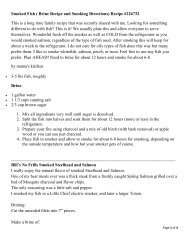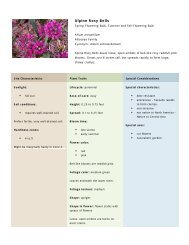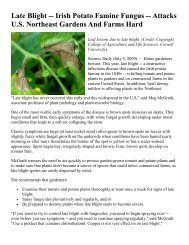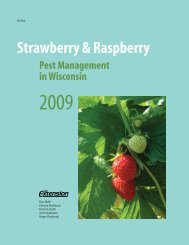Growing Blackberries in Your Home Garden, EC 1303 (Oregon ...
Growing Blackberries in Your Home Garden, EC 1303 (Oregon ...
Growing Blackberries in Your Home Garden, EC 1303 (Oregon ...
- No tags were found...
Create successful ePaper yourself
Turn your PDF publications into a flip-book with our unique Google optimized e-Paper software.
Pests and other problemsThe most common disease problems <strong>in</strong>cludecane and leaf spot, yellow rust, anthracnose, andfruit rot. The most important <strong>in</strong>sect problem is redberry mite. Photos and suggested control measuresfor these pests can be found on the Internet(http://berrygrape.oregonstate.edu/; http://pnwpest.org/pnw/<strong>in</strong>sects). Many of these problems canbe controlled with dormant and delayed dormantapplications of lime sulfur and oil.Cold <strong>in</strong>jury can cause crop loss. Trail<strong>in</strong>g blackberriesare the most sensitive to cold. Hot summertemperatures can cause fruit sunburn (ultravioletlight damage), which causes white drupelets.For more <strong>in</strong>formationBlackberry Cultivars for <strong>Oregon</strong>, C. F<strong>in</strong>n andB.C. Strik, <strong>EC</strong> 1617.<strong>Grow<strong>in</strong>g</strong> Raspberries <strong>in</strong> <strong>Your</strong> <strong>Home</strong> <strong>Garden</strong>,B.C. Strik, <strong>EC</strong> 1306.Laboratories Serv<strong>in</strong>g <strong>Oregon</strong>: Soil, Water, PlantTissue, and Feed Analysis, J. Hart, EM 8677.Soil Sampl<strong>in</strong>g for <strong>Home</strong> <strong>Garden</strong>s and SmallAcreages, M. Robotham and J. Hart, <strong>EC</strong> 628.Many OSU Extension Service publicationsmay be viewed or downloaded from the Web.Visit the onl<strong>in</strong>e Publications and Videos catalog athttp://eesc.oregonstate.edu/catalogCopies of our publications and videos also areavailable from OSU Extension and ExperimentStation Communications. For prices and order<strong>in</strong>g<strong>in</strong>formation, visit our onl<strong>in</strong>e catalog or contactus by fax (541-737-0817), e-mail (puborders@oregonstate.edu), or phone (541-737-2513).Blackberry or raspberry?It’s easy to tell a blackberry from araspberry. In a raspberry (left), the fruitreceptacle (core of the berry) rema<strong>in</strong>s onthe plant when you pick the fruit, leav<strong>in</strong>g anopen<strong>in</strong>g <strong>in</strong> the fruit. In a blackberry (right),the receptacle is part of the fruit that you eat;the fruit has no open<strong>in</strong>g.© 2008 <strong>Oregon</strong> State UniversityTrade‐name cultivars are listed as illustrations only. The OSU Extension Service does not endorse any listed cultivar or <strong>in</strong>tend any discrim<strong>in</strong>ation aga<strong>in</strong>st othersnot listed.This publication was produced and distributed <strong>in</strong> furtherance of the Acts of Congress of May 8 and June 30, 1914. Extension work is a cooperative program of<strong>Oregon</strong> State University, the U.S. Department of Agriculture, and <strong>Oregon</strong> counties. <strong>Oregon</strong> State University Extension Service offers educational programs,activities, and materials without discrim<strong>in</strong>ation based on age, color, disability, gender identity or expression, marital status, national orig<strong>in</strong>, race, religion, sex,sexual orientation, or veteran’s status. <strong>Oregon</strong> State University Extension Service is an Equal Opportunity Employer.Published July 1989. Revised March 2008.












